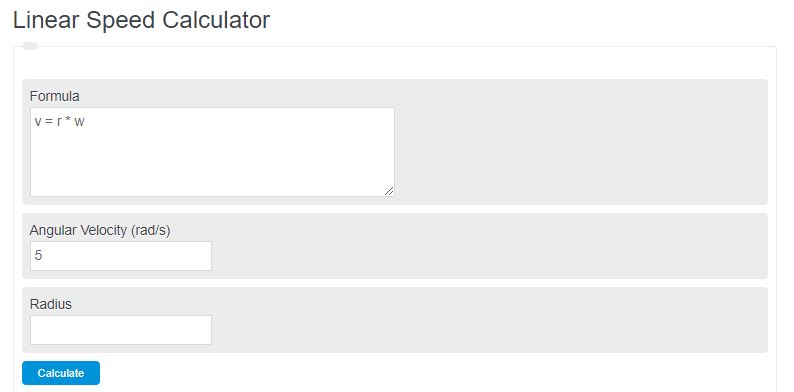Enter the total angular velocity and radius of rotation into the calculator to determine the linear tangent speed of an object in rotation. This calculator can also evaluate either the angular speed or radius when given the values of the other variables.
Linear Speed Formula
The following formula is used to convert an angular velocity into linear speed.
v = r * w
- Where v is the linear velocity
- r is the radius
- w is the angular velocity (rad/s)
To calculate linear velocity, multiply the length of the radius by the angular velocity.
What is Linear Speed?
Imagine running away from a zombie. As scary as it is, you need to better your chances of escape. Figuring out the zombie’s linear speed can give you a head start.
You might be thinking, “what is linear speed?” As a whole, it’s how fast a moving object travels in a linear path.
In the case of a zombie pursuit, you need to find a way to top your linear speed to outrun the brain-eating living dead.
Stick around to learn more about linear speed.
How Do You Find Linear Speed?
The answer lies in a standard formula. The formula to find linear speed is v=ωr. Let’s break it down.
- v is the linear speed
- ω is the angular speed
- r is the radius of one complete rotation.
You might want to also know how to calculate the angular speed. The formula for it is ω=Δθ/Δt. In other words, it means the total distance traveled divided by the total time.
Before crunching your numbers in, make sure your total distance traveled is converted to radians. This is the angle degree of an arc. Time, on the other hand, is calculated in seconds.
What is an Example of Linear Speed?
One of the most common examples of linear speed is measuring the speed of a running athlete. You can also determine the speed of the earth’s rotation.
If you’re thinking, isn’t the earth rotating in circles, as opposed to a running athlete going through a straight line? Well, linear speed measures the rotation’s speed by straightening out the circular motion.
It’s like cutting one bit of a circle and straightening out the edges to form a line.
Is Linear Speed the Same as Velocity?
This question is a matter of speed vs. velocity. Both are measured differently. Speed is found in the distance traveled of a moving object over the time taken to travel.
Meanwhile, velocity takes the object’s direction into account. It’s calculated by dividing the change in position and the change in time.
What’s the Difference Between Angular and Linear Speed?
If you’re trying to distinguish angular and linear speed, look for one main aspect. Angular speed measures the number of turns per time or rate of travel. On the other hand, linear speed looks at the distance traveled per time.
For example, let’s look at a race car speeding around a circular track. Angular speed would find the number of turns per minute or hour. The latter would estimate the miles per hour of the race car.
How Do You Find the Linear Speed of a Ferris Wheel?
The best way to find linear speed is through practice problems. In this instance, we’re trying to establish the linear speed of a Ferris wheel.
The wheel’s radius is 30 feet, and one revolution takes about 70 seconds. That being said, the linear speed needs to be in the same unit, which is ft/s.
- The first thing we need to find is the angular speed. Since it’s one rotation, then the angle would be 360 degrees.
- Remember to convert it to radians by multiplying it with π/180.
- That would give us 0.09 radians per second after dividing it by the time, 70 seconds.
- After finding the angular speed, now you just need to divide it by the radius (30 feet).
- Your answer should be 2.7 feet per second.
Pro tip: You can alternatively calculate your linear speed by finding the circumference of the Ferris wheel (2π(r)=188.4) and dividing it by the time (70 seconds).
To Conclude
Measuring the linear speed of a moving object will prove helpful in several ways. We hope you benefited from learning how to calculate it. You never know; it can save your life.
Linear Speed Example
Let’s look at an example problem.
- First, we need to measure the radius of rotation. For this example, we will say the radius is 50m.
- Next, we must determine the angular velocity. For this example, we will assume this value is 100 rad/s.
- Finally, we calculate the linear speed using the formula above. This results in a value of 5,000 m/s.
It’s important to note that in the formula above, the linear speed with have units of the radius per second. So if the radius is in ft, the speed will be ft/s.
FAQ
Linear speed it often referred to as the instantaneous tangential velocity of a rotating object.

